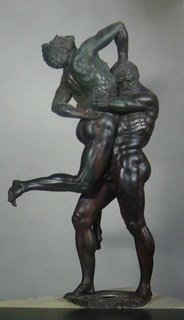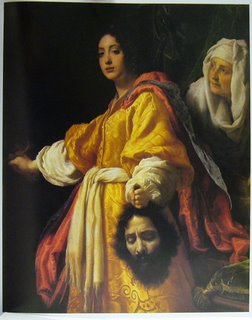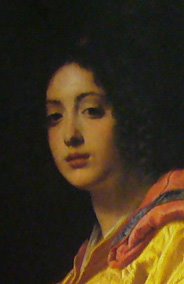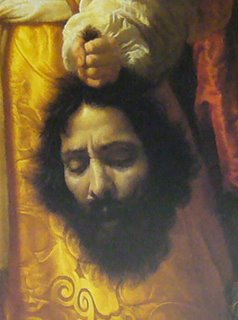A.I.C. : The Age of Cosimo di Medici
About three years ago, the museum hosted one of my favorite shows of all-time --- primarly due to the inclusion of the following two objects:

In the 1540's, to celebrate the consilidation of their autocratic control over Florence (and the duchy of Tuscany)-- the Medici family began planning for a monument to brute force -- centering on the depiction of Hercules and Anteus set into a fountain. After several false-starts, Nicolo Tribolo was chosen to design the monument, and Ammanati to make the broze figures, completed in 1559.

What an incredible masterpiece ! The power that ripples through every joint and tendon -- connecting to a majestic, awesome, symphonic unity. I went to stare at it every week it was on display. It's brutal -- monstrous -- dynamic --- relentless -- just like the modern secular states that eventually would dominate world history.
Ammanati -- you rule ! -- and much longer, and much better, than the Medici ever did.

Then there was this masterpiece by Christofano Allori (1557-1621) painted near the end of his life in 1616-18. Christofano was almost an exact contemporary of Caravaggio -- and like any other painter in his right mind -- followed the lead of that incredible genius -- into a world of dark, dramatic, sordid passions.

The story, as you must have guessed, celebrates that most notorious femme fatale, Judith, and her lover/victim, Holofernes, who touched her flesh just once -- and
immediately lost his head. Above is a detail of that crafty Jewess, Judith -- which, according to historians, is also a portrait of Christofano's young lover.

And this is a detail of poor Holofernes -- the great Iraqi general -- which is also said to be a portrait of the artist himself -- an aging devotee to the muse -- who also lost his head to a striking young woman. Look at the languor in her eyes -- and look at the severed power of his head -- and it tells a story that is tragic -- but not necesssarily one that should be considered cautionary.

In the 1540's, to celebrate the consilidation of their autocratic control over Florence (and the duchy of Tuscany)-- the Medici family began planning for a monument to brute force -- centering on the depiction of Hercules and Anteus set into a fountain. After several false-starts, Nicolo Tribolo was chosen to design the monument, and Ammanati to make the broze figures, completed in 1559.

What an incredible masterpiece ! The power that ripples through every joint and tendon -- connecting to a majestic, awesome, symphonic unity. I went to stare at it every week it was on display. It's brutal -- monstrous -- dynamic --- relentless -- just like the modern secular states that eventually would dominate world history.
Ammanati -- you rule ! -- and much longer, and much better, than the Medici ever did.

Then there was this masterpiece by Christofano Allori (1557-1621) painted near the end of his life in 1616-18. Christofano was almost an exact contemporary of Caravaggio -- and like any other painter in his right mind -- followed the lead of that incredible genius -- into a world of dark, dramatic, sordid passions.

The story, as you must have guessed, celebrates that most notorious femme fatale, Judith, and her lover/victim, Holofernes, who touched her flesh just once -- and
immediately lost his head. Above is a detail of that crafty Jewess, Judith -- which, according to historians, is also a portrait of Christofano's young lover.

And this is a detail of poor Holofernes -- the great Iraqi general -- which is also said to be a portrait of the artist himself -- an aging devotee to the muse -- who also lost his head to a striking young woman. Look at the languor in her eyes -- and look at the severed power of his head -- and it tells a story that is tragic -- but not necesssarily one that should be considered cautionary.


3 Comments:
I love the painting of the same subject by Caravaggio. I saw it when I visited Rome last August which demostrated the killing itself. Judith in this painting is beautiful and almost tragegic looking...intersting to see the same subject being dealt with differetly, but both with mastery.
The story told about this painting is that the model for Judith was Allori's mistress; for the woman in the background -- her mother; and that the St John is a self-portrait. (The last we know for sure, it is).
Allori's greatest work are imho the gorgeous grotesques on the ceilings of the Ufizzi -- which are almost never reproduced. Perhaps because they are "merely decorative". Sei Shonagon has an interesting theory about them: the Ufizzi were at the time just that -- Offices. There were numerous petents waiting in the vestibules; and waiting and waiting. The grotesques on the celings helped them while the time away.
How thoughtful. Don't you wish somebody could to this to your motor vehicle department - or the airport lobby? (Instead of the usual TV with CNN on)?
Thankyou, Red, for your memory of Caravaggio -- who was ten years younger than Christofano -- though he painted his Judith ten years earlier. And look at the difference ! Caravaggio asks "what would it really be like for a slender young woman to slice off the head of the successful soldier who had just bedded her ?" --- while Christofano asks, a bit self indulgently, "what if I were Holofernes ?" The energy in Caravaggio's space -- well, there's nothing like it in European painting -- that's why he's a superstar --- while Christofano -- though also extraordinary -- by comparision -- is just a bit flaccid. It's almost like comparing a great tragedy with a great comedy. And thankyou, Gawain, for noting that the old woman in Christofano's version is possibly a portrait of his young mistress's mother --- accounting for the solicitious gaze she casts on her sweet daughter -- completely oblivious to the bloody murder she has just perpetrated. (and thanks for the reference to the Ufizzi -- all the more reason to travel to Florence again)
Post a Comment
<< Home